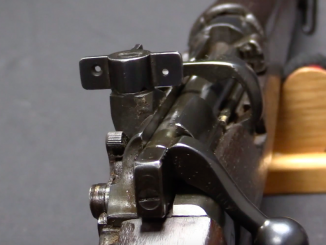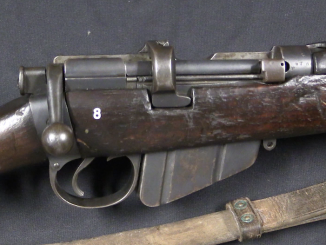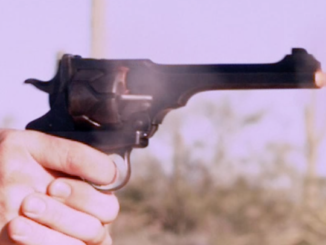In the mid 1930s, Turkey updated and overhauled the bolt action rifles in its inventory, to bring them all up to that same standard for sights, ammunition, sling configuration, etc. Most of the rifles overhauled were Mausers of various vintages, but some were other designs, like Gewehr 88s…and British Lee Enfields. Yep, the Turks converted Lee Enfield rifles (mostly Magazine Lee Enfields and Charger-Loading Lee Enfields, but also some SMLEs) to have Mauser sights and furniture and fire 8mm Mauser ammunition.
These hybrid rifles have no formal designation, and are usually called “Enfausers” or “Mausenfields” by people in the collecting community. Only a few hundred were brought into the US, apparently by accident among vast imports of Turkish Mauser rifles over the last few decades. They are made from rifles captured in the siege of Kut and the Gallipoli campaign – this particular one came from the 103rd Mahratta Light Infantry, which surrendered at Kut in April 1916.
Thanks to viewer Wyatt for providing the rifle for me to film!




I wonder how long before firing stress messes with the receiver… gunsmith attention is needed for that. I could be wrong.
“how long before firing stress messes with the receiver”
Depend on ammunition (charge) used. I have no data about Turkish 7,9 mm cartridges, however IIRC Lee-Enfield system is rather durable, so if no some super-heavy loadings were used it should work probebly.
is: “(…)probebly.”
should be: “(…)properly.”
Turk 7.92mm rounds are notoriously ‘hot’. They used the 150gn flat-based bullet as used by the Germans before the adoption of the sS ball and surplus ammo often chronographs at 2900-3000 fps. Forgotten Weapons recommend its not used in semi-autos (https://www.forgottenweapons.com/why-we-dont-use-turkish-8mm-surplus/)
[off-topic so ignore if you wish]
Recently I encounter… hmm… interesting advert
https://mpopenker.livejournal.com/2311632.html
for T-62
U.S. CIVILIAN
DEFENSE
WEAPON!
which itself is nothing atypical – .22 rim-fire self-loading rifle in form factor of sub-machine gun. However some claims of that advert are… far-flung to put it mildly.
However I am curious when that advert was published?
I suspect 1950s. It suggest that U.S. citizen (or at least advert makers though so) were easily influenced by movie (see Invasion, U.S.A.)
If this was introduced in 1960s name T-62 is bit ironical taking in account it is also designation of tank deployed by Soviet Union.
In the late 1950s, Hy Hunter, the big mail-order house in Los Angeles, CA, bought a large lot of the new Armalite AR-7 “Explorer” takedown .22 LR “survival” rifles direct from Fairchild Industries.
They used them as the basis for this and other “semi-combat” adaptations with additions like wooden stocks with Thompson-style pistol grips, muzzle compensators, and extended 20 or 30-shot magazines.
They even made a “machine pistol” version,getting around the 1934 NFA restriction on converting rifles to “pistols” by having Fairchild make a run of AR-7 receivers that could not accept the rifle barrel, but had a special short (6″) barrel permanently mounted in the receiver. Years later, Charter Arms would do a similar trick to create the Explorer II pistol; they put the lineup notch for the barrel 180 degrees from its normal position on the rifle receiver.
They sold their “assault rifle”,”machine carbine” and “machine pistol” versions for several years. Most ads were similar to this, implying that they would be “the first line of defense” in event of a Soviet airborne invasion. (And this was two decades before Red Dawn, to boot.)
I used to see these at gun shows now and then years ago. My impression is that not to many were sold, at least east of the Mississippi.
If we Easterners were going to shoot Soviet paratroopers, we’d be more likely to use something like a surplus M1, M1903, or a war trophy Mauser. After all, it’s really not polite to do an enemy a minor injury.
As one Russian Army intel colonel (retired), later FSB, once told me, they never considered invading the U.S. to be a practical or even sane plan.
“You have too many ‘deer rifles’ over here”, were his exact words.
cheers
eon
Sounds like the previous token wise man amongst radical madmen. “I would never invade America. There would be a rifle behind every blade of grass.”
“Now you too can take on those pesky Russki paratroopers with our AR7 dress up kit!!!” “Scare them to death with the “Chicago typewriter” appearance!!!” Thanks for the laugh.
Never heard of the Enfausers, thanks, Ian. Not sure I’d trust firing one with 7.92×57.
Daweo – that appears to be an Armalite AR-7 (introduced 1959) with a “dress up” kit and a load of advertising hype. So, maybe T-62 = 1962. Never heard of that before, either!,
I wonder about that “1893 Mauser” stamp in that context. Could it be that the importer wasn’t sure if the barrels were for the later .323″ bore “S” bullet, as opposed to the earlier .318″ spec?
The stamp may have been a “better safe than sorry” legal measure, as in “don’t use military surplus ‘S’ bullet ammunition in this rifle“.
Regardless of bore spec, etc., I’d say the lower-pressure pre-S ammuntion or equivalent handloads would be about the only thing I would even try firing in one of these.
cheers
eon
Russell Braddon’s book on Kut is lovely-
https://www.amazon.com/Siege-Russell-Braddon/dp/0670643866
I had never heard of these conversions, and find them a fascinating example of attempting uniformity for the sake of it.
The Turks managed to take an excellent, ten shot rifle, and spend a lot of time and trouble to turn it into a five shot rifle. Why?
If they wanted to use the SMLEs they captured, just get hold of .303 ammunition. It wasn’t scarce or expensive. If that caused too many logistical problems, then either don’t bother, or improve your logistics operation. It seems like an immense waste of time to convert an excellent .303 rifle into an inferior 7.92 mm one. But as a fan of Forgotten Weapons, I’m glad they did!
For that matter, they could have run a 7.62 x 54R Mosin-Nagant chambering reamer into the Enfields, and opened up the extractor and bolt face a bit, and just used the Nagant ammunition they captured from the Russians in 1914-17.
Other than the shoulder, base, and rim diameter being slightly greater than 0.303in, the two cartridges and their bore specs are nearly identical. Enfield bullet= .311″ diameter, Nagant bullet= .310″ diameter.
The target wouldn’t have noticed the difference.
cheers
eon
The old myth of “weakness”
Going right back to the united state’s army trials of the late 1880s and early 1890s, the requirements stated that the trials rifles should have front locking lugs, because rear locking was considered to be ‘weak’
Why?
It seems that it was because someone said so.
Proponents of “rear locking is weak” (and “old fashioned”)tend to get a little bit anxious when it’s pointed out that the Browning machine guns, BAR, FAL and FN MAG are all rear locking…
In a Lee action in good condition, the bolt is far more highly stressed than the receiver.
Unfortunately a lot of the guns that reached the united state, appear to have been scrappers.
The case hardening in the locking seats worn through, and they were incapable of being adjusted back to acceptable headspace limits by fitting the available replacement bolt heads.
“Weak” is of course capable of explaining any observation.
It’s just not necessarily a correct explanation.
Is a Lee action that is in good condition and correctly chambered, safe to fire with 8×57 correct for that chamber?
The pressure original specs are about the same as .303, so why not? And neutered American loadings…
As for cheap surplus that’s been stored for decades in hot climates… ah sure it’s the gun that’s weak